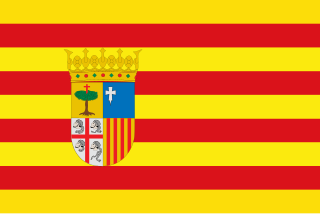
Aragon is an autonomous community in Spain, coextensive with the medieval Kingdom of Aragon. In northeastern Spain, the Aragonese autonomous community comprises three provinces : Huesca, Zaragoza, and Teruel. Its capital is Zaragoza. The current Statute of Autonomy declares Aragon a historic nationality of Spain.

Zaragoza also known in English as Saragossa, is the capital city of the province of Zaragoza and of the autonomous community of Aragon, Spain. It lies by the Ebro river and its tributaries, the Huerva and the Gállego, roughly in the centre of both Aragon and the Ebro basin.

José Antonio Labordeta Subías was a Spanish (Aragonese) singer, songwriter, poet, writer and political activist. He was described by The Gran Enciclopedia Aragonesa 2000 as "The most important Aragonese singer-songwriter". He began singing in an attempt to give more relevance to his poetry; his songs are well-known and beloved anthems in Aragón. Poetic songs such as "Aragón", "Canto a la Libertad" or "Me dicen que no quieres" were also sung all around Spain.
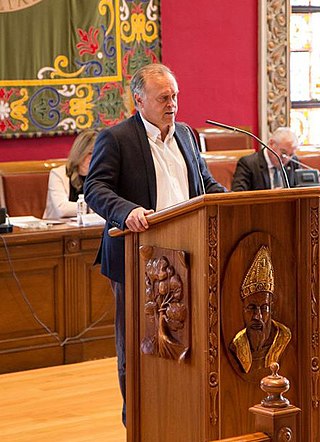
Miguel Pardeza Pichardo is a Spanish retired professional footballer who played as a forward.

The Diocese of Tarazona is a Latin diocese of the Catholic Church located in north-eastern Spain, in the provinces of Zaragoza, Soria, Navarre and La Rioja, forming part of the autonomous communities of Aragón, Castile-Leon, Navarre and La Rioja. The diocese forms part of the ecclesiastical province of Zaragoza, and is thus suffragan to the Archdiocese of Zaragoza.

The Diocese of Barbastro-Monzón is a Latin diocese of the Catholic Church located in north-eastern Spain, in the province of Huesca, part of the autonomous community of Aragón. The diocese forms part of the ecclesiastical province of Zaragoza (province), and is thus suffragan to the Archdiocese of Zaragoza.

The Aljafería Palace is a fortified medieval palace built during the second half of the 11th century in the Taifa of Zaragoza in Al-Andalus, present day Zaragoza, Aragon, Spain. It was the residence of the Banu Hud dynasty during the era of Abu Jaffar Al-Muqtadir. The palace reflects the splendor attained by the Taifa of Zaragoza at its height. It currently houses the Cortes of the autonomous community of Aragon.

Sos del Rey Católico is a historic town and municipality in the Cinco Villas comarca, province of Zaragoza, in Aragon, Spain.
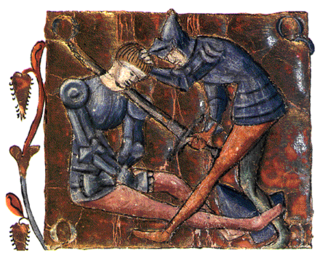
The Battle of Morella (14 August 1084×88), southwest of Tortosa, was fought between Sancho Ramírez, King of Aragon and Navarre, and Yusuf al-Mu'tamin, King of Zaragoza, while the former was engaged in a campaign of conquest against the latter. All surviving sources for the battle are either later by a generation or literary in character, and they are confused on the chronology and dating of the event. The encounter was a defeat for Sancho and sparked a brief reversal of fortunes in the Navarro-Aragonese Reconquista. The Castilian hero, Rodrigo Díaz de Vivar, El Cid, was a general for al-Mu'tamin at the time. According to the Aragonese Crónica de San Juan de la Peña (c.1370), Sancho later sought out El Cid, who had also defeated his father in the Battle of Graus (1063), and defeated him in the year 1088. However, the Crónica is the only source mentioning such an encounter and, as it was written three hundred years later, most leading scholars give no credence to this claim, which was probably intended to justify the prerogatives of Peter IV of the Crown of Aragon.
Fuencalderas is a village of the autonomous community of Aragon, in Spain, in the comarca (county) of the Cinco Villas, in the province of Zaragoza. Until 1975 was an independent municipality, year in which was fused with the municipality of Biel, giving place to the municipality of Biel-Fuencalderas. In 1996 step to be constituted as "Lower Local Entity" within the same municipality.

Navarro-Aragonese was a Romance language once spoken in a large part of the Ebro River basin, south of the middle Pyrenees; the dialects of the modern Aragonese language, spoken in a small portion of that territory, and the Navarrese dialect can be seen as its last remaining forms. The areas where Navarro-Aragonese was spoken might have included most of Aragon, southern Navarre, and La Rioja. It was also spoken across several towns of central Navarre in a multilingual environment with Occitan, where Basque was the native language.

The Poema de Yuçuf or Poema de Yusuf is an anonymous poem written in Aragonese in the Aljamiado Arabic script from the fourteenth century. It was written in a strophic form called "cuaderna vía" by a Morisco poet. The text was discovered incomplete, but 380 verses have been preserved.

The 2023 Aragonese regional election was held on Sunday, 28 May 2023, to elect the 11th Cortes of the autonomous community of Aragon. All 67 seats in the Cortes were up for election. The election was held simultaneously with regional elections in eleven other autonomous communities and local elections all throughout Spain.
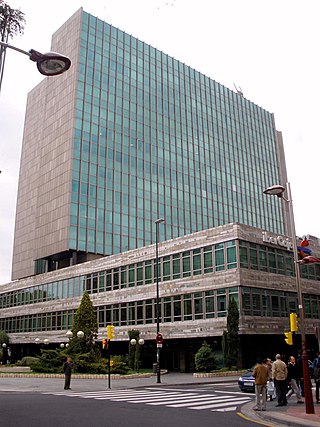
Ibercaja Banco, S.A., stylised as iberCaja, is a Spanish financial services company based in Zaragoza. It was created by the Caja de Ahorros and Monte de Piedad of Zaragoza, Aragón and Rioja (Ibercaja) in 2011, to develop its financial activity, being initially the shareholder of 100% of the bank. After the acquisition of Caja3 by Ibercaja Banco, in the process of banking restructuring in Spain, 87.8% was owned by Ibercaja and 12.2% by the three Caja3 shareholders.
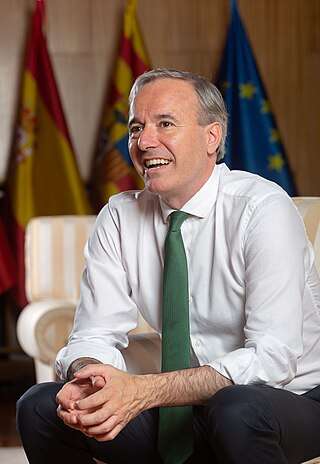
Jorge Antonio Azcón Navarro is a Spanish politician, serving as the President of the Government of Aragon since 2023. He is the president of the People's Party of Aragon. He was also a city councillor and the mayor (2019–2023) of Zaragoza.

The Palace of the Diputación del General del Reino de Aragón, historically known as Casas del Reino or Casa de la Diputación del Reino, was a building in the Plaza de la Seo in Zaragoza in 1436, as the headquarters of the Diputación del General del Reino de Aragón, the Cortes and the Justicia de Aragon.

Elisa Moreu Carbonell is a Spanish lawyer, legal scholar and professor of law.

Las Fuentes is a district of Zaragoza (Spain). It borders the districts of Casco Antiguo, Torrero - La Paz and San José and the municipalities of Pastriz, El Burgo de Ebro, Fuentes de Ebro and Mediana de Aragón. In addition to the neighborhood of Las Fuentes, it includes others such as Montemolín or the area surrounding the Pabellón Príncipe Felipe. It extends as far as the neighborhood of La Cartuja. Its borders are delimited by the rivers Ebro, Huerva, Miguel Servet Street and the railway bypass.























